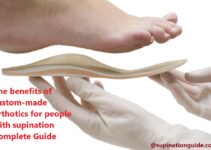Do you suffer from supination and want to find a perfect sandal that provides firm support?
This article will guide you through the essential elements you need to consider while selecting a sandal that offers comfort with style. You’ll learn which qualities define a good supportive sandal so you can shop smarter – and safer!
Supination, or “underpronation,” occurs when one’s foot rolls too far outward when walking, putting additional strain on the feet, ankles, and legs. It is a common condition and can result in increased pain while standing or walking if not treated. Wearing the correct footwear that provides ample support to the arch helps decrease symptoms associated with supination and reduce the chance of injury. Sandals designed for individuals with supination are a great option for those looking for both comfort and stability.
This guide will discuss how sandals can benefit individuals with supination by providing adequate support as well as discuss what factors should be considered when shopping for sandals designed to help treat this condition. It will also provide tips on how to properly care for sandals once they have been purchased and worn regularly.
Explanation of what supination is and its effects on the feet
Supinated, or high-arched feet, occur in about 20% of the population and can cause significant issues with balance and stability for affected individuals. It is typically caused by a combination of inherited foot anatomy and lax ankle and calf muscles that cannot absorb the shock of impact during walking, leading to overpronation (the opposite of supination). Supination presents itself as an outward rolling motion when the person walks. This movement can be identified when looking at the walking pattern of someone with a high arch: as they walk, their inner heel strikes first and then transfers all their weight to their outside edge as they push off.
The condition is generally associated with a variety of issues including general discomfort, foot pain such as plantar fasciitis, ankle sprains, shin splints and Achilles tendonitis. If left untreated or unsupported over time, these issues can have long-term effects on mobility.
Wearing the correct shoes for supinators is paramount in order to properly manage these concerns. The best shoes for this condition should provide cushioning to absorb shock, midsole stability for medical arch support and added strength around crucial areas such as the ankles to provide better biomechanical support overall. The ideal shoes should also feature non-slip soles for added traction that prevents slipping on wet surfaces or sloped surfaces.

What are sandals for supination?
Sandals for supination are designed to provide optimal arch support, balance and cushioning for those suffering from overpronation. They have a thickened midsole and an elevated heel cup to help correctly position the foot and reduce the amount of pressure placed on the arch.
They also feature wide, deep heel cups that provide lateral stability with many having adjustable straps to secure the foot in place. Many sandals provide good shock absorption, enabling them to reduce impact on joints which is beneficial for those who are prone to joint issues due to over pronation.
In addition, they typically have a cushioned midsole which provides arch support and has excellent grip in wet condition. Due to their unique design they are an ideal choice if you need appropriate footwear that provides optimum stabilization of your feet during daily activities or when engaging in physical activities such as walking or running.
Definition and characteristics
Supination is a medical condition that results in the rolling out of the foot, putting too much pressure on the outside edges. This can cause pain in the ankle and heel, along with other problems due to poor shock absorption and inadequate arch support. To address these issues, it is important to find a sandal that supports the natural content of your foot as opposed to ones that make your feet roll outward.
The first step in finding supportive sandals for supination is getting an idea of what kind of shoes work best for this condition. The main characteristics of a good sneaker or sandal should include:
- A cushioned midsole or foam liner: These are designed to create more flexibility and help absorb shock when walking or running.
- An outsole with horizontal treads and an angled heel: This prevents slipping and helps increase stability as well as traction on both wet and dry surfaces.
- A wide forefoot with toe box at least half an inch longer than your longest toe: A wider forefoot allows toes to move around those crucial areas such as arch support or bending forward. The toe box should never cause any restrictions on movement when flexing toes forwards side-to-side, up-and-down, possibly due to swelling throughout long walks or runs.
- A raised inner cushion line/arch support bar: The cushion line should be present both inside and out with slight flexibility for wiggle room in order for one’s feet not to feel cramped when walking throughout long spans of time. It provides motion control that aids in correcting rolling movements from supination generated by weak ankles thus creating better stability during activities.
Comparison with regular sandals
Sandals designed specifically for supination often feature additional support such as medial wedging, lateral forefoot flaring, and heel wedge cushioning. This reduces the amount of stress on the outside of the foot while still allowing flexibility. Supination-specific sandals also provide arch support, much like a regular sandal. However, this arch should be higher than that of a regular sandal to match the increased height often found in people with supinated feet.
Supination-specific sandals also have more flexibility in the sole as well as more cushioning where needed; this helps to reduce discomfort and fatigue for those who supinate their feet excessively when walking or standing for long periods of time. The extra cushioning also makes them comfortable enough to wear on long walks or hikes, due to its superior shock absorption qualities. They should be made from lightweight materials that offer breathability and allow feet to flex naturally while providing needed stabilization. Additionally, these sandals feature adjustable straps which allow you to personalize the fit according to your individual needs and preferences while ensuring that you enjoy your activity without having any painful consequences later on.
How do sandals for supination provide support?
In order to ensure that sandals for supination provide enough support, they must feature soles with greater body control, arch and ankle support.
The best sandals boast orthotic-friendly design features that are specially developed to cater to flat feet and help relieve pressure on the knees and back. Such features include oversized toes, wide toe boxes and adjustable Velcro straps which allow for a secure fit. This is especially important for those with supination, as it helps reduce over pronation when walking or running.
For example, built-in arch cookies can give feet an extra boost of support— providing midfoot stability and cushioning the long arch connective tissues from fatigue. Additionally, molded foot beds featuring deep heel cups and contoured arches can keep arches lifted throughout the day or during exercise activities.
Types of support (arch, heel, cushioning, etc.)
There are four types of support to consider when selecting foot support sandals for supination: arch, heel, cushioning, and stability.
Arch Support: Quite simply, arch support helps to reduce pain and fatigue in your feet. It is important to purchase sandals with supportive arches that accommodate the unique shape of your feet since this can distribute your body weight more evenly and reduce pressure when standing or walking for long periods.
Heel Support: Since heel support is especially important for supination sufferers as it provides stability and reduces pressure on the heels, you should make sure to select sandals that have an adequate level of cushioning around the heel area. Ideally, the cushioning should completely mold around your foot in order to provide full coverage and protection against shock while walking or running.
Cushioning: Some manufacturers incorporate special materials such as memory foam into their designs in order to provide additional shock absorption on impact. This type of cushioning is especially beneficial for those who suffer from pain in their feet due to pronation or supination issues–it can help relieve pressure points and absorb some of the shock associated with dealing with these conditions.
Stability: Sandals specifically designed for people with pronation or supination issues typically have additional straps along the instep area which helps keep it secure on your foot so that it does not shift or slide as you move, thus providing extra stability when standing or walking. Additionally, some styles also feature wedged heels which further increases stability by aligning the ankle joint in a neutral position.
Importance of correct fit
A correct fit of any sandal is essential, both for comfort and support. Sandals for supination should fit snugly in the heel, to ensure proper foot alignment and stability. It is also beneficial for people with weak ankles or those who are prone to rolling their ankles. To check that a sandal fits correctly, walk around wearing it before making a purchase and ensure that your heel does not slip while in motion.
You may need to try on different styles of sandals to determine which ones provide the best fit and level of support for you. Ideally, your foot should feel secure but comfortable inside the sandal: too loose and you risk instability; too tight and it can cause discomfort. Look for adjustable straps or buckles as these can help to customize the fit even further, so that you can be sure your feet are properly supported throughout everyday activities or exercise.
The insoles of right fit sandals should also be made from supportive materials — either rubber, foam, cork or textile — with enough cushioning so they contour to your arch without creating pressure points on any parts of the foot when walking. This will help to protect against developing any further problems related to supination while also allowing your feet to move naturally without pain or discomfort.
Benefits of using sandals for supination
Sandals made specifically for people with supination offer several important benefits. Most notably, they provide additional arch and heel support, which is crucial for people with low arches or flatter feet who experience an extremely high level of pronation when they walk. This extra level of support helps to keep the feet in their ideal alignment, reducing the risk of developing foot and ankle problems or worsening existing conditions.
Additionally, sandals for those with supination offer enhanced shock absorption. Many models are designed with cushioning comfort insoles that help to absorb impact and reduce strain on the feet as you move throughout your day.
Finally, sandals made for those with supination come in a variety of secure styles such as buckles and Velcro straps that help to keep them secure while walking or running.
Pain relief
Pain relief is a common reason to opt for special sandals if you suffer from supination. Supinated feet are very prone to foot, ankle, leg and even lower back pain if not supported correctly. Footwear that suits your feet can provide a great way to reduce the long-term effects of this condition.
Sandals with arch support and cushioning can be extremely helpful in this regard. Special orthotic or specially designed adjustable sandals are the best choice when looking for extra pain relief. Make sure they have plenty of room in the toe box, as cramped toes can lead to further discomfort in your feet and ankles. People with supination usually benefit from more firm cushioning than softer insoles for effective shock absorption throughout the day.
Look for sandals that provide both arch support and good cushioning, such as cork-based insoles, as well as adjustable straps which allow you to customize the fit according to your own individual needs and requirements. Making sure your feet are properly supported will help reduce pain associated with supination, allowing you to get back on track with whatever activity you’re participating in faster!
Improved posture
The proper fit and design of sandals for supination can help reduce discomfort caused by poor biomechanics of the feet. These sandals also provide better support than regular shoes, improving overall posture as well as relieving lower back and hip strain. With a solid heel cup, a firmer midsole that is angled slightly to the outside, and straps or lacing that holds the foot securely in place, you will notice a difference in your posture when wearing them.
Studies suggest that wearing sandals specifically designed for supination helps to evenly balance your weight on your feet when you stand and walk. This weight-bearing distribution helps minimize back pain, leg fatigue and joint stress while preventing overpronation which is thought to be linked to gradual structural problems in the body over time.
When shopping for new shoes or sandals, it’s important to try them on in store before buying them. The right pair should feel comfortable right away; if they don’t fit properly then you likely won’t experience the full benefits of their design features such as improved posture. It’s also important to ensure they fit correctly when you bend down, squat or jump since it’s during these activities that improper footwear can cause issues. Make sure there is sufficient space in front of your toes when you are stationary or actively moving so that no pressure areas develop on the upper of your foot from rubbing inside the shoe or sandal.
Reduced risk of injuries
Reducing the risk of injuries is a primary concern for anyone wearing sandals for supination, as improper support can lead to pain in the feet, ankles, and legs. Without the necessary stability offered by shoes that are designed specifically for supinators, there’s an increased chance of sprains, strains, and condition flare-ups.
When shopping for sandals for supination, look for those that provide a high level of arch support and cushion both along the heel and ball of the foot. Additional features like adjustable straps and contoured exteriors provide further reinforcement needed to create a secure posture while walking or running. Sandals with extra straps along with robust midsoles can help improve stability even further.
High-quality inner soles should also include integrated cushioning to relieve pressure points in your feet and ankles. Pick up smaller details such as rubber pods on outsoles also ensure skid resistance and give extra grip while navigating rough terrain or wet surfaces.
Conclusion
It is evident that sandals designed for supinated feet offer a variety of benefits including increased arch support and cushioning, along with added stability. Most importantly, they provide enough support to help prevent and reduce the risk of injury.
Additionally, wearing the right pair of sandals can help improve your gait and walking motion, which will contribute to better overall foot health and comfort.
While there is no single solution that works for everyone, choosing shoes or sandals best suited to your individual foot shape will offer you the ultimate protection when it comes to preventing overpronation related issues. The sole should fit properly without slippage in order to ensure optimal comfort and stability during all types of activities. Finally, wherever possible opt for breathable materials as these will keep your feet feeling cool and dry throughout the day.
FAQ’s
What kind of support do I need for supination?
Supinators require shoes that provide ample cushioning, flexibility, and lateral support.
Do supinators need arch support?
Yes, supinators need arch support to prevent their feet from rolling outward, causing ankle instability and foot pain.
Do you need special shoes for supination?
Yes, supinators require shoes that are specifically designed to accommodate their supination condition and provide adequate support and stability.
Can supinators wear stability shoes?
Yes, supinators can wear stability shoes as they provide the necessary support and stability for the foot to avoid rolling outward.
Can supination be corrected?
Yes, supination can be corrected with proper footwear, stretching exercises, and strength training.
Is supination more powerful than pronation?
No, supination is not more powerful than pronation as both motions are equally important for maintaining balance and stability during physical activities.
What muscles are weak if you Supinate?
Supination is often associated with weak muscles in the lower leg, including the tibialis anterior, peroneals, and gastrocnemius.
What percentage of people have supination?
Approximately 10% of the population have supination as their natural foot motion during walking and running.
What are the benefits of supination?
Supination helps to provide shock absorption, increase stability, and improve balance during physical activities.
How do you strengthen supination?
You can strengthen supination by performing exercises that target the muscles in the lower leg, including calf raises, ankle eversion exercises, and lateral band walks. Additionally, proper footwear can also help to strengthen the muscles that support supination.
See Also :
- Best running shoes for supination
- Best sandals for supination
- Best shoes for over supination
- Best shoes for supination and plantar fasciitis
- Best shoes for supination


